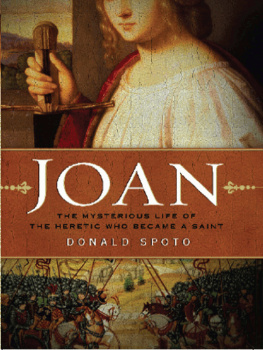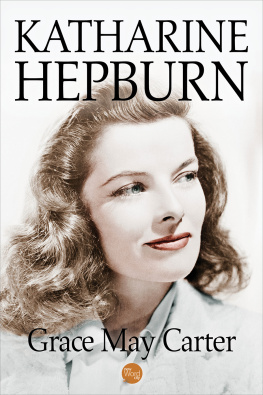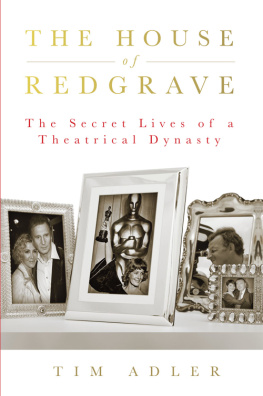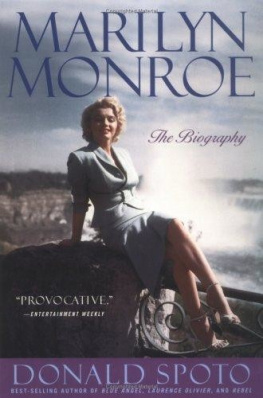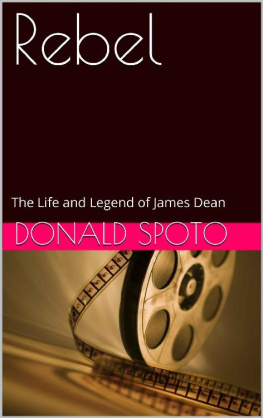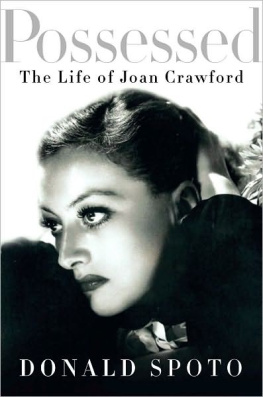A LSO BY D ONALD S POTO
Possessed: The Life of Joan Crawford
High Society: The Life of Grace Kelly
Spellbound by Beauty: Alfred Hitchcock and His Leading Ladies
Otherwise Engaged: The Life of Alan Bates
Joan: The Mysterious Life of the Heretic Who Became a Saint
Enchantment: The Life of Audrey Hepburn
In Silence: Why We Pray
Reluctant Saint: The Life of Francis of Assisi
Jacqueline Bouvier Kennedy Onassis: A Life
The Hidden Jesus: A New Life
Diana: The Last Year
Notorious: The Life of Ingrid Bergman
Rebel: The Life and Legend of James Dean
Dynasty: The House of Windsor from Victoria to Diana
A Passion for Life: The Biography of Elizabeth Taylor
Marilyn Monroe: The Biography
Blue Angel: The Life of Marlene Dietrich
Laurence Olivier: A Life
Madcap: The Life of Preston Sturges
Lenya: A Life
Falling in Love Again: Marlene DietrichA Photo-Essay
The Kindness of Strangers: The Life of Tennessee Williams
The Dark Side of Genius: The Life of Alfred Hitchcock
Stanley Kramer Film Maker
Camerado: Hollywood and the American Man
The Art of Alfred Hitchcock
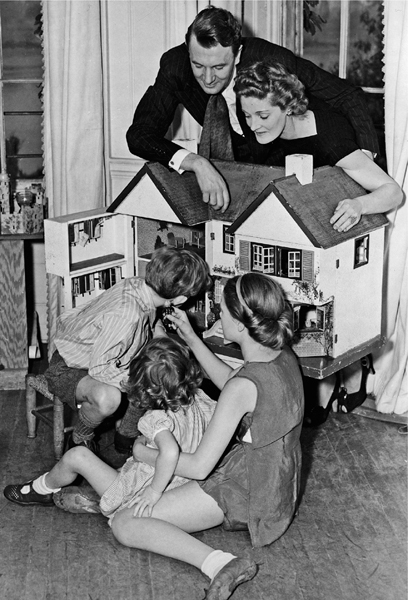

Copyright 2012 by Donald Spoto
All rights reserved.
Published in the United States by Crown Archetype, an imprint of the Crown Publishing Group, a division of Random House, Inc., New York.
www.crownpublishing.com
Crown Archetype with colophon is a trademark of Random House, Inc.
Library of Congress Cataloging-in-Publication Data
Spoto, Donald, 1941
The Redgraves : a family epic / by Donald Spoto.1st ed.
p. cm.
Includes bibliographical references.
1. Redgrave, Michael, Sir. 2. ActorsEnglandBiography. 3. Redgrave family. I. Title.
PN2598.R42S68 2012
791.430280922dc23 2012001296
[B]
eISBN: 978-0-307-72017-7
Frontispiece photo by Two Cities/The Kobal Collection
All insert photographs by British Film Institute, Film Stills Archive,
unless otherwise noted
Jacket design by Nupoor Gordon
Front jacket photograph Annie Leibovitz/Contact Press Images
v3.1
For Ole
again, and always
right next to the right one
T IM C HRISTENSEN , Danish composer and lyricist
It takes the pity of God
to get to the bottom of things.
E NID B AGNOLD , The Chalk Garden
Contents
Introduction and Acknowledgments
T HIS BOOK IS the result of more than thirty years of research; it is also a record of many valued friendships.
The project began when I first met Michael Redgrave in January 1981. At seventy-two, he was suffering greatly from the debilitating effects of the illness that would end his life four years later. He no longer gave interviews, and avoided meeting strangers, but he made an exception when I was living in London and working on my biography of Alfred Hitchcock. In response to my letter, Sir Michaels secretary, Joan Hirst, replied that he would welcome me for a brief chat about The Lady Vanishes, the 1938 Hitchcock thriller in which Redgrave had made his movie debut.
At two oclock on the appointed afternoon, I arrived at his cozy mews house in a quiet, cobbled street of Belgravia. Joan Hirst had asked me to limit my visit to no more than a half hour, but my host would hear none of that. Three hours later, following a lengthy interview and several rounds of drinks, he finally allowed me to depart, but with the promise that we would meet again. Sir Michaels memories of The Lady Vanishes that afternoon were precise, witty and richly detailed; he had also confided more of his private life and career than he had perhaps intended.
After his death in 1985, when I was researching the life of Laurence Olivier, I was drawn closer into the family circle by Michaels widow, Rachel Kempson Redgrave, who had been a close confidante of Oliviers second wife, Vivien Leigh. My subsequent years of friendship with Rachel provided even more insight into the long history of her family, for by this time, the three children of Michael and RachelVanessa, Lynn and Corinhad achieved international fame and many accolades for their own career achievements. I treasure the transcripts of my conversations with Rachel and my letters from her, as I do the memories of our many lunches at West End restaurants and late-afternoon cups of strong tea at her flat in Flood Street, Chelsea.
It was clear to both of us that one day, as she hoped, I would undertake this book. In the intervening years, I researched and published other biographiesthe lives of Ingrid Bergman and of Alan Bates, for examplebut the Redgraves were always on my mind, as they were topics for discussions during interviews. The many people who were forthcoming are acknowledged here; some of them, like Michael and Rachel, also became good friends.
I N THE TWENTIETH century, the most famous knights of the British theater were John Gielgud, Ralph Richardson, Laurence Olivier, Alec Guinness and Michael Redgrave. Biographies of the first four appeared on both sides of the Atlanticbut no life of Michael Redgrave has been published in the United States, and no Redgrave family history has appeared anywhere, despite their remarkable theatrical lineage that spans centuries and continues to flourish even as I write these words.
Corin Redgrave wrote a brief memoir; he was also the author of his fathers autobiography and of books credited to other family members. These he stitched together, from articles and from compilations of Michaels published lectures (The Actors Ways and Means and Mask or Face, for example, published in 1953 and 1958); Corin also relied heavily on two outdated, half-century-old sources: Richard Findlaters Michael Redgrave: Actor (1956) and a long interview with Michael conducted by Lillian Ross (1962). Corins book, and the ghostwritten lives of his relatives that he produced, copied identical passages from these sources, and repeated the same unfortunate errors of time, place and circumstance.
Corin was a splendid actor, a person of strong principles and of unassailable goodwill, but his talents did not extend to careful authorship. The same may be said of Vanessa and Lynn: the formers book is long on political and social history but comes up short as autobiography; the latters hundred-page reminiscence is but a brief, selective prelude to a massive collection of diet recipes. Like those of their parents, the signal achievements of the Redgrave children and grandchildren have deserved fuller treatment than any of them provided. Their books, sometimes entertaining and provocative, are radically incomplete and unreliable as history, biography or autobiography.
Serious problems arose from the gaps in the Redgrave books. Why, for example, did they all insist that Michael was born illegitimately when the historical record proves otherwise? Why did Lynn Redgrave, despite all written evidence to the contrary, always claim that her fathers diaries contained no mention of her birth or accomplishments? I was convinced that these and other critical matters relative to their personal and professional livesand the tangle of their relations with one anothermerited examination and assessment: hence the book you are now reading.


